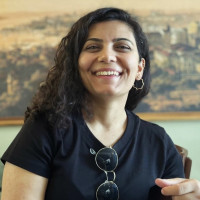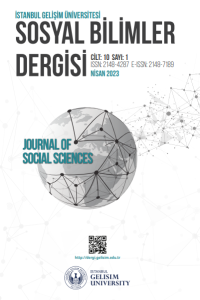Research Article
Book Review
Aim & Scope
Istanbul Gelisim University Journal of Social Sciences is an international, multidisciplinary peer-reviewed journal. IGUJSS is being published twice a year.
The goal of the Journal is to establish an academic platform for the social sciences including economic and administrative sciences, Political Science and International Relations. Contributing to the production of knowledge and creation of value; be a qualified reference source in academic publishing; and giving priority to ecological, economic and social sustainability are the primary goals of the journal.
Since the day of its first issue, the editorial team of the IGUJSS has unconditionally believed that these goals can only be achieved through respect for freedom of science and freedom of speech as well as unconditional commitment to the ethical codes of research and publication.
Submitted articles are evaluated by at least two doctoral referees by double-blind method. When there is a tie, it is sent to the third referee. All appointed referees have a doctorate degree. Accepted articles are announced on our website. Book reviews are evaluated by our editorship and those deemed appropriate are published. There are no Article Processing Fees (APC) or article submission fees in this journal.
In our journal, scientific articles within the framework of the topics of ADMINISTRATIVE SCIENCES, BUSINESS, COMMUNICATION, ECONOMICS, LOGISTICS, PHILOSOPHY, POLITICAL SCIENCES, PSYCHOLOGY, PUBLIC RELATIONS, SOCIOLOGY, STATISTICS are accepted.
Scientific articles with ARCHEOLOGY, ARCHITECTURE, EDUCATION, FINE ARTS, HISTORY, INFORMATION TECHNOLOGY, LAW, LINGUISTICS and LITERATURE are not accepted.
IGUJSS publishes theoretical and empirical studies, book reviews and annotated bibliographies.
IGUJSS has an international editorial and advisory boards and publishes articles in Turkish, English, Russian, French and German languages.
Author Guidelines
Principles of Publication and Rules for Writing (PDF)
ISTANBUL GELISIM UNIVERSITY JOURNAL of SOCIAL SCIENCES
PRINCIPLES of PUBLICATION and RULES FOR WRITING (Rev. 3)
CHAPTER ONE
Purpose, Scope, Content and Definitions
Definitions:
Journal: Istanbul Gelisim University Journal of Social Sciences
Owner: Istanbul Gelisim University (IGU) Rector on behalf of founding Foundation of University,
Publication Board: Lecturers determined by the Rectorate of IGU who work in the field of Social Sciences and Humanities,
Board of Referees: Lecturers from at least five different universities who are selected by the editorial board,
Editor: Faculty members to be appointed by the Rectorate of IGU.
Assistant Editors: Lecturers from related departments to be determined by the Rectorate of IGU.
Editorial Board: Lecturers and students determined by Editor.
Purpose and Scope:
1. The purpose is to organize the procedures of publication of Journal of Social Sciences within Istanbul Gelisim University.
2. The aim of the journal is to create a common academic platform from different disciplines within the humanities such as economic and administrative sciences, political science and international relations. In addition to this, book introductions and reviews may also be included.
3. In our journal, scientific articles within the framework of the topics of ADMINISTRATIVE SCIENCES, BUSINESS, COMMUNICATION, ECONOMICS, LOGISTICS, PHILOSOPHY, POLITICAL SCIENCES, PSYCHOLOGY, PUBLIC RELATIONS, SOCIOLOGY, and STATISTICS are accepted. Scientific articles with ARCHEOLOGY, ARCHITECTURE, EDUCATION, FINE ARTS, HISTORY, INFORMATION TECHNOLOGY, LAW, LINGUISTICS and LITERATURE are not accepted. The journal is published twice a year (April and October).
4. Journal is an international peer-reviewed journal.
Content:
The articles sent to journal;
1. Should be prepared using appropriate research, methods and models specific to the field and should have the capacity to make a contribution to the field.
2. It can criticize or review a previously published article and have the qualities of research or review that present new and remarkable views in this regard.
3. Articles that discuss, criticize or explain a concept or theory, biography and the review articles, and the the translations that contribute to the scientific field can be included to journal.
4. The journal should written in the format suitable for publishing principles.
5. In addition to those listed above, book introductions and / or reviews may also be included in the journal.
CHAPTER TWO
Duties
Boards of Journal:
1. Duties of Editorial Board:
a. It meets twice a year except for extraordinary circumstances.
b. Publication Board reviews the submitted journal articles, formats and examines them, determines the experts in the field (based on thesis, publications and expertise) and sends for peer review to the referees.
c. According to the result of peer review, decides whether the article will be published or not and arranges the publication order of articles accepted by referee.
d. Decides for a special issue with absolute majority.
2. Advisory Board:
The referees will review the submitted articles in terms of method, content and authenticity and decide whether they are appropriate for the publication or not. According to the contents of the articles, this may vary in each issue.
3. Editor:
a. Provides coordination between members of the Publication Board.
b. Invites the Publication Board twice a year to conduct preliminary evaluations of the submitted articles, except for specific periods.
c. Takes editorial responsibility on behalf of the Publication Board.
d. In exceptional circumstances related to his / her duties, he / she authorizes one of his / her assistants to continue with the process.
4. Assistant Editors:
They ensure coordination between the members of the Editorial Board, monitor the peer review process and help editors in the evaluation of the reports of the referees.
5. Publication Board:
a. Assists the editor for the follow-up of articles and in technical issues.
b. Arranges the articles submitted for publication and prepares the journal for printing.
CHAPTER THREE
Evaluation
1. The articles considered suitable in terms of format and fields by the Publication Board are sent to expert referees for evaluation. If both of the referee evaluations are positive, the article will be accepted for publication. If one is positive and the other is negative, the article is sent to a third referee. The articles to be corrected for publication must be submitted by the authors within 20 days at the latest (including postal mail). The corrected text will be sent back to the referees who request the amendment, if it is deemed necessary by the Publication Board.
2. Submitted articles will be published with the final decision of the Publication Board following the approval of two referees as "publishable". The authors must consider the criticism, evaluation and correction of the referee and the Publication Board. In cases where the author does not agree, the author has the right to report them on a separate sheet with the reasons.
3. The articles with approval from referees are published by the Publication Board in order of the date of completion of the referee reports, based on the subject content of the journal.
4. The Rectorate of Istanbul Gelisim University pays certain terms to the referees who fill in the Article Evaluation Form of the Journal. The referees submitting their evaluation reports within 30 days are paid 100 TL. In case of the submitting report within 60 days 50 TL will be paid. No payment will be made for evaluation reports submitted after 60 days.
5. Any articles submitted to the journal will not be returned, whether published or not.
6. The authors of articles which are not accepted will be informed through e-mail.
CHAPTER FOUR
Rules
The articles to be included in the journal must bear the rules contained in the following clauses:
1. The journal is published twice a year, in April and October, in accordance with the status of "International Peer Reviewed Journal". Where necessary, it may also be published as a Special Issue with the decision of absolute majority of the Publication Board.
2. Articles submitted to the journal must have not been published or sent for publication elsewhere.
3. The articles submitted for publication to Journal:
a. Original Research Article: A study that contributes to knowledge, refutes previous theses or introduces a new perspective, introduces new documents,
b. Review Article: A study on a controversial or ambiguous subject, criticizing the entire bibliography and reaching to a conclusion,
c. Book Introduction: A study of book introduction of current and newly published books on their own publishing areas,
d. Book Review: The journal is open to studies on the review of current and newly published books in the subject areas of journal.
e. The publication board will decide about the publication of any work.
4. The copyright of any articles published in the journal will belong to the journal. The author agrees that the copyright granted to the publication in the journal is all inclusive. There is no fee for submitting an article to our journal. The publication board sends three journals to authors in return for copyright. Republishing a published article in another publication is subject to the permission of the journal. There is no article processing fee (APCs) in our journal.
5. For translated articles sent to the journal, the permission of the author of the article and the original text is required. Translation work is also sent to the referees for approval, just like copyright studies.
6. The opinions in the articles published at the journal are the personal opinions of the authors; and they do not contain the official view of Istanbul Gelisim University and journal boards.
7. If corrections are requested from the author, such corrections should be made within 20 days at the latest and must be delivered to the Publication Board.
8. The authors must state their titles, the institutions they are employed at, their correspondence addresses, telephone numbers and e-mail addresses.
9. Any non-substantial corrections in the articles to be published may be made by Editorial Board.
10. The author(s) may withdraw the article one day before it is sent to the referees at the latest. In case if the authors want to withdraw the article for which the evaluation process had started, the evaluation costs are to be covered by the author.
11. The articles submitted to the journal are also reviewed by the plagiarism screening tool. iThenticate software is used for this purpose. Authors must upload the iThenticate report to the system during the article submission process. Reports are evaluated by the editorial and those over a certain percentage are rejected or correction is requested.
Spelling Rules:
1. Journal contains articles which have original and scientific qualities related with the content of journal as a result of evaluation of referee board.
2. Language of articles in the journal can be Turkish, English, French, German and Russian. The abbreviation of spelling and punctuation is based on the latest edition of the Turkish Language Institute's Signature Guidelines. The sentences should be clear and understandable in terms of language and expression and they should be in accordance with scientific measures.
3. Articles submitted for publication should not be more than approximately 8,000 words including summary and bibliography, except in exceptional cases.
4. The graphics used in the text should be sent in a graphics format that can be opened in Windows, the pictures should be sent in JPG format and 300 pixels resolution. The digital records of the texts and graphics (pictures, tables, attachments, etc.) sent to the journal should be sent with a CD. The originals of documents and photographs related to the topic of the article or the ones that are appropriate for the print should be selected. The name of the author should be given under the photograph and at the edge of the figure.
5. Articles containing high level of linguistic and expressive errors will not be evaluated.
6. In Latin languages, the name should be given in its original form. Names in other languages should be used in English or Turkish transliterations.
7. The articles should be uploaded to ULAKBIM DergiPark system (Address: https://dergipark.org.tr/en/pub/igusbd). The "IGUSBD Ethical Declaration and Copyright Transfer Form" must be completed and uploaded to the system at the time of submission.
Format:
1. There should be 2.5 cm spacing at the right, left, bottom and up of the page.
2. In the main body of the article, the font should be Times New Roman with 12 point, line spacing should be 1.5 lines and aligned to both sides.
3. A paragraph should start a tab (1.25cm) inside.
4. As the header information, the short name of the article should be written in all capital letters at the left. The name of the author should not be written using top or bottom headers. This will spoil the transparency of reviewing process.
5. In case of block quotations, the quotation should be inside a tab (1.25 cm). When the quotation is completed, reference should be given (source, year, page number).
Structure
The APA-style text is divided into sections. The main sections are:
Title
Abstract
Introduction
Method
Results
Discussion
Bibliography
Summary
Appendixes.
Title
1. It will be on the first page. The full title of the text should be written with capital first letters and centered.
The name of authors will be added to the next line in the same format. Finally, the authors' institutions are written in the same writing format.
2. By moving down with clicking on Enter twice, information such as the duty of author in his/her institution, any awards received, information about any studies where the article is derived from and contact information of the author will be provided from the left (not centered).
Abstract
An abstract that will not exceed 150 words (in Turkish and English, if the article is in the language of the article, then the summary in that case) must be present. The title of the abstract should be put as "Abstract". In addition, 5 English (Keywords) and 5 Turkish keywords should be provided, the word Keywords should be written from a tab (1.25 cm) inside and in Italic format.
Summary
At the end of the bibliography section of the article, a summary not to exceed 750 words (in Turkish articles should be in English / English articles should be in Turkish) it must be found. In German, French and Russian articles respectively English and the Turkish summary should also be available.
Sub Headings
1. Level: Centered, Bold, First Letters Capitalized, remaining letters not capitalized
2. Level: Left Aligned, Bold, First Letters Capitalized, remaining letters not capitalized
3. Level: A tab inside, Bold, Only the first letter of title Capitalized, remaining letters and words not capitalized, dot at the end.
4. Level: A tab inside, Italic, Only the first letter of title Capitalized, remaining letters and words not capitalized, dot at the end.
5. Level: A paragraph inside, Bold, Only the first letter of title Capitalized, remaining letters and words not capitalized, dot at the end.
Tables, Graphics, Figures and Pictures:
1. The table, graphic, figure and picture names should be placed under the table. Table, graphic, figure and picture texts and figures should be written with font size 8.
2. Table, graphic, figure and pictures should be numbered.
3. The line spacing between the texts in tables and figures should be set as 1.
Rules on In-Text References:
Type of Reference Initial reference to the work in the text Other references to the same work in the text Initial reference to the work in the text in parenthesis format Other references to the same work in the text in parenthesis format
Single author Öztaş (2014), Öztaş (2014) (Öztaş, 2014, p. 9) (Öztaş, 2014, p. 9)
Two authors Erdem and Öztaş (2015) Erdem and Öztaş (2015) (Erdem & Öztaş, 2015, p. 8) (Erdem & Öztaş, 2015, p. 8)
Three authors Altun, Şahin and Öztaş (2017) Altun et.al. (2017) (Altun, Şahin, & Öztaş, 2017. p. 5) (Altun et.al.., 2017, p. 5)
Four authors Musso, Weare, Öztaş and Loges (2006) Musso et.al. (2006) (Musso, Weare, Öztaş, & Loges, 2006, p. 4-7) (Musso et.al.., 2006, p. 4-7)
Five authors Öztaş, Myrtle, Chen, Masri and Nigbor (2002) Öztaş et.al. (2002) (Öztaş, Myrtle, Chen, Masri, & Nigbor, 2002, p. 8) (Öztaş et.al.., 2002, p. 8)
Six or more authors Öztaş et.al. (2005) Öztaş et.al. (2005) (Öztaş et.al.., 2005, p. 7) (Öztaş et.al.., 2005,
p. 7)
Author groups (as understood with abbreviation) Istanbul Gelisim University (IGU, 2018) IGU (2018) (Istanbul Gelisim University [IGU], 2018, p. 11)
(IGU, 2018, p. 11)
Author groups (without abbreviation) Istanbul Gelisim University (2018) Istanbul Gelisim University (2018) (Istanbul Gelisim University, 2018,
p. 6) (Istanbul Gelisim University, 2018, p.6)
If more than one reference is cited in the same parenthesis, the one that should be written first in bibliography should be the first.
If two or more works of the same author are quoted, the letters following the alphabetical order are added to the publication year: For example: (Arıkan, 2009a); (Arıkan, 2009b). The first of these will refer to two different works in bibliography.
If the author of the work is not mentioned, the first few words of the work are used. When referring to that work, the name of the book is written in italics and then the date is specified:
As mentioned in another source (Genel İşletme, 2017) …
As mentioned in Genel İşletme (2017)
If more than one articles with the same author surname is quoted the names of the authors should be indicated in the sentence, even if the publication years of the works are different. For example: Mehmet Ünal Şahı̇n (2015); Muzaffer Şahin (2010). Personal interviews should be mentioned in the text but not in the bibliography.
For example: (Adnan Duygun, personal interview, February 2017).
It is essential to access the primary sources in the studies, but if they could not be accessed due to circumstances, the source quoted or mentioned is specified in the submission. For example: (Cited By: Çelikbilek, 2016, p. 25); (mentioned by Karaca, 2017, pp. 32). The source information is not included in the cited or mentioned work.
Rules for Bibliography:
1. The full information of cited reference will be provided. Any works that are not cited will not be indicated in bibliography.
2. Refer to the latest edition of the work.
3. If available, the page number of the article and the volume number of the issue should be added.
4. If the DOI number is present, it must be appended to the last part of the reference.
A. Books
In the "bibliography", the surname of the author, the initials of author's first name (sometimes the initials of first two names), the year of publication (in brackets), the name of the work, publication information will be specified. Book names are written in entirely small and italic letters after the first letter of the title (except for special names).
a. Book with single author or editor
Surname of the author, Initials of the author's name. (Year). The title of the book is italic, and after the first letter (except for special names) all letters will be not capitalized. Printing Place: Publisher.
For example: AYKAÇ, B. (1999). İnsan kaynakları yönetimi ve ı̇nsan kaynaklarının stratejik planlaması. Ankara: Nobel Yayınevi.
Surname of the Editor, Initials of the Editor's name. (Ed.). (Year). The title of the book is italic, and after the first letter (except for special names) all letters will be not capitalized. Printing Place: Publisher.
For example: GÜMÜŞ, İ. (Ed.). (2017). Genel işletme. İstanbul: İstanbul Gelı̇şı̇m Ünı̇versı̇tesı̇ Yayınları
b. Books with two or more authors or editors
Surname of the first author, Initials of the first author's name. and Surname of the second author, Initials of the second author's name. (Year). The title of the book is italic, and after the first letter (except for special names) all letters will be not capitalized. Place: Publisher.
For example: KÖTEN, E., ERDOĞAN, B. (2014). Engelli gençler, sosyal dışlanma ve internet. İstanbul: İstanbul Gelı̇şı̇m Ünı̇versı̇tesı̇ Yayınları
Surname of the first author, Initials of the first author's name., Surname of the second author, Initials of the second author's name. and Surname of the third author, Initials of the third author's name. (Year). The title of the book is italic, and after the first letter (except for special names) all letters will be not capitalized. Place: Publisher
For example: KARACA, R. K., ÖZKURT, F. Z. (2017). New concepts and new conflicts in global security issues. İstanbul: İstanbul Gelı̇şı̇m Ünı̇versı̇tesı̇ Yayınları
c. Reviewed or extended editions
Surname of the author, Initials of the author's name. (Year). The title of the book is italic, and after the first letter (except for special names) all letters will be not capitalized. (Reviewed/ Extended ... Edition) Printing Place: Publisher.
For example: ALPAY, N. (2004). Türkçe sorunları kılavuzu (Reviewed
second edition). İstanbul: Metis.
ç. Books with Indefinite Authors
The title of the book is italic, and after the first letter (except for special names) all letters will be not capitalized. (Year). Place: Publisher.
For example: The 1995 NEA almanac of higher education. (1995). Washington DC: National Education Association.
d. Books with two or more volumes
Surname of the author, Initials of the author's name. (Year). The title of the book is italic, and after the first letter (except for special names) all letters will be not capitalized (Volume ....) Printing Place: Publisher.
For example: TINMAZ, H. (2015). Engelsiz Bilişim 2013 sempozyumu bildirileri (Volume 2). İstanbul: İstanbul Gelı̇şı̇m Ünı̇versı̇tesı̇ Yayınları
e. Translated Books
Surname of the author, Initials of the author's name. (Year). The title of the book is italic, and after the first letter (except for special names) all letters will be not capitalized. (Initials of Name of Translator, Surname of Translator, Trans.) Printing Place: Publisher.
For example: LUCKE, R. (2008). Girişimcinin el kitabı. (Ü. Şensoy, Trans.) İstanbul: Türkiye İş Bankası Kültür Yayınları.
f. An article in a compiled book
Surname of the author, Initials of the author's name. (Year). Title of article. The title of the book is italic, and after the first letter (except for special names) all letters will be not capitalized (pp. pages) Printing Place: Publisher.
For example: SAYAN, S. (2002). Dünya Ekonomisi ve Türkiye: Globalleşme, Liberalizasyon ve Kriz. Yerel ekonomilerin sürdürülebilir kalkınması ve Çanakkale örneği (pp. 33). Ankara: Türkiye Ekonomi Kurumu.
g. Chapter or article in Reference Books
Surname of the author, Initials of the author's name. (Year). Title of article. The title of the book is italic, and after the first letter (except for special names) all letters will be not capitalized (pp. pages) Printing Place: Publisher.
For example: TOY, H., ELMACI, D. (2015). Cumhuriyetin ilanı. Kronolojik Türkiye tarihi ansiklopedisi (pp. 6-9). İstanbul: Karma Kitaplar.
B. Articles
For Journal Articles:
Surname of the author, Initials of the author's name. (Year, and month, if any.) The title of article will be with capitalized first letter of first word, and the remaining letters will not be capitalized, if not a private name. Name of Journal and Initial Letter of Each Word in Capitalized, Volume, Italic (Issue). Page Numbers. doi: xxxxxx
For example: ÖZDEN, K., ERDOĞDU, D. & GÜL, S. (2017, October). Kriz yönetiminde üretim yönetimi stratejileri ve politikalarının kullanılmasıyla ilgili bir alan araştırması. İstanbul Gelişim Üniversitesi Sosyal Bilimler Dergisi, Volume 4 (2), 23-50. doi:10.17336/igusbd.348761
C. Other Resources
a. Movie
Surname of the Director, Initials of the Director's name. (Director). (Year). Name of the Movie in Italic format. Production city: Name of production company.
For example: TYLDUM, M. (Director). (2014). The Imitation Game. USA: Black Bear Pictures.
b. Internet Sources
Surname of the author, Initials of the author's name. (Date of publication of article). The title of article will be italic and with capitalized first letter of first word, and the remaining letters will not be capitalized, if not a private name. Date of Access: Day Month Year, link to the article.
For example: Yüksek Öğretim Kurulu (YÖK) (10.01.2018) Akademisyenlere yurt dışı imkanı. Date of Access: 15.01.2018, https://www.cnnturk.com/turkiye/akademisyenlere-yurt-disi-imkani
c. Unpublished Graduate Theses
Surname of the author, Initials of the author's name. (Year). The title of thesis will be italic and with capitalized first letter of first word, and the remaining letters will not be capitalized, if not a private name (Unpublished Graduate Thesis). Name of Institution, Location of Institution.
For example: SELIMLER, H. (2006). Türk bankacılık sektöründe sorunlu kredilerin varlık yönetim şirketlerince tasfiyesi, seçilmiş ülkeler ve Türkiye uygulaması (Unpublished Doctoral Thesis). Marmara Üniversitesi Bankacılık ve Sigortacılık Enstitüsü, İstanbul.
Ethical Principles and Publication Policy
PUBLICATION ETHICS AND PUBLICATION POLICY
Istanbul Gelisim University Journal of Social Sciences (IGUJSS) is an international peer-reviewed journal by at least two international reviewers who are specialized in the area. IGUJSS aims to publish original articles interdisciplinary to form a common academic community. The journal also aims to contribute to produce academic value and knowledge in the interdisciplinary areas. The journal is published two times a year (April and October), but additional issues may be published. Papers are welcomed after a strict peer-reviewed process. The papers are only taken into account in review process in terms of their significance, uniqueness, readability, contribution, signification, relevance, and language. Plagiarism is not acceptable in IGUJSS, thus, an electronic plagiarism programs (iThenticate, Turnitin and intihal.net) are used for evaluating the papers’ originality. The decision process is onto editors and the process contain acceptance, acceptance with revisions, or rejection. The publication ethics of the IGUJSS conform to the international ethical standards for involved parties including authors, editors, and peer reviewers.
IGUJSS welcome following disciplines: ADMINISTRATIVE SCIENCES, BUSINESS, COMMUNICATION, ECONOMICS, LOGISTICS, PHILOSOPHY, POLITICAL SCIENCES, PSYCHOLOGY, PUBLIC RELATIONS, SOCIOLOGY, and STATISTICS.
IGUJSS’s registered editors and reviewers are responsible for ensuring the quality of the published papers and the contribution to the academia fully committed to fulfilling the ethical responsibilities that are set by COPE (http://publicationethics.org/resources/guidelines.)
Section A: Publication and authorship
1. The double blind method is applied.
2. All submitted papers are under strict peer-review process by at least two international reviewers who are specialized in the area.
3. The papers are only taken into account in review process in terms of their significance, uniqueness, readability, contribution, signification, relevance, and language.,
4. It is not possible to re-review rejected papers.
5. The decision process contains acceptance, acceptance with revisions, or rejection.
6. If an author gets revision or resubmission for the paper, it is not certain that the revised version will be accepted or published.
7. The paper acceptance is constrained by such legal requirements as copyright infringement and plagiarism.
8. Submitting the same paper to different journals is not acceptable.
Section B: Authors’ responsibilities
1. All Authors mentioned in the paper must have significantly contributed to the research. All authors must contribute to the research.
2. All authors must confirm that their research is original. Plagiarism is not acceptable.
3. All authors must confirm that the paper has not been published in any other journals.
4. All authors must report any mistakes that are in the published paper.
5. All authors must confirm that the paper has not been submitted for other journals’ review process.
6. All authors must provide corrections and retractions of the paper.
7. All authors must state that all relevant data that are in mentioned in the paper are genuine and real.
8. All authors must inform the Editors about the conflict of interest.
9. All authors must participate in the peer-review process.
10. All authors must cite the sources that are used in the research.
Section C: Reviewers’ responsibilities
1. Reviewers must define non-cited and relevant sources in the paper.
2. Reviewers must mind that all papers’ information is confidential.
3. Reviews should be objective.
4. Reviewers must notify the Editors about any similarity in the paper among other papers.
5. Reviewers must declare their opinions regarding supporting objectives.
6. Reviewers must be equal to all authors, but if there are conflicts of interest resulting from personal views, the reviewer should not review the paper.
Section D: Editors’ responsibilities
1. All Editors must guarantee the integrity of the academic level and the papers’ quality.
2. All Editors should be determined about their decisions and should not overturn the decisions.
3. All Editors should mind the confidentiality of the reviewers.
4. All Editors are responsible for the quality of the submitted papers’ content.
5. All Editors must mind the authors and the regarding readers’ requests.
6. All Editors must make literal corrections if it is necessary and publish these corrections.
7. All Editors should be clear and controllable about the funding sources that contribute to the journal.
8. All Editors should make their decisions based on the uniqueness, clearness, relevance, and language of the submitted research.
9. All Editors must be certain that all published researches correspond to the international guidelines.
10. All Editors are responsible for rejecting or accepting the papers.
11. All Editors should involve in any malpractice in the journal or the process of publishing and also should take action.
12. All Editors should be transparent in accepting papers and should have proof to present.
13. All Editors must ensure that there are no conflicts of interest between editors, paper authors, reviewers, and editorial board.
14. All Editors should be selective in the process of accepting the papers.
Price Policy
There are no Article Processing Charges (APCs) or article submission charges in our journal.
Indexes
Citation Indexes
Other Indexes
Journal Boards
Owner on Behalf of Istanbul Gelisim University

Prof. Dr. Bahri Sahin received his undergraduate degree from the Department of Mechanical Engineering at Gazi University in 1977, his graduate education from the Department of Mechanical Engineering at Yıldız Technical University's (YTU) Institute of Science and Technology in 1979 with a TÜBİTAK scholarship, and completed his Ph.D. in the Nuclear Energy Institute Nuclear Technology Program at Istanbul Technical University ITU) in 1985 wıth a TÜBİTAK Honorary Scholarship.
He worked as a research assistant between 1979 and 1983 and as a lecturer between 1983 and 1986 in the Department of Energy Engineering at ITU's Mechanical Engineering Department and served as Assistant Professor in Naval Architecture and Marine Engineering between 1986 and 1989 and as an Associate Professor between 1989 and 1995. He has been a Professor since 1995.
Prof. Dr. Bahri Sahin served as Deputy Head of his Department between 1988 and 1999 at Yildiz Technical University, Division Head between 1992 and 2007, Head of the Department between 1999 and 2009, and Founding Dean of Faculty of YTU Naval Architecture and Maritime Department since 2009. He was also elected to the Board of Directors of the United Nations Industrial Development Organization's (UNIDO) International Center for Hydrogen Technology (ICHET) in 2010.
Prof. Dr. Bahri Sahin has conducted many international studies in the fields of thermodynamics, energy production systems, energy technologies, design and optimization of thermal systems, and energy economy. He was elected to the Turkish Academy of Science (TÜBA) as a principal member by the Scientific Board of TUBİTAK through Decision No. 212 on October 6, 2012. Prof. Dr. Bahri Sahin also served as the rector of Yildiz Technical University from 2016 to 2020 and is the current Rector of Istanbul Gelişim University.
Journal Editorial Board


Prof. Dr. Tevfik ERDEM
Ankara Üniversitesi Dil, Tarih ve Coğrafya Fakültesi Sosyoloji bölümünden 1991 yılında mezun oldu. Yüksek Lisansını 1996 tarihinde Kırıkkale Üniversitesi SBE’de “Sivil Toplum ve Türkiye Gerçeği” adlı teziyle aldı. Doktorasını Hacettepe Üniversitesi SBE’de “Yoksulluk üzerine sosyolojik bir çalışma: Ankara kent yoksulları” adlı teziyle 2003 yılında tamamladı. Ankara Hacı Bayram Veli (Gazi) Üniversitesi, İİBF, Siyaset Bilimi ve Kamu Yönetimi Bölümünde öğretim üyesi olarak görev yapmaktadır. Kara Harp Okulu (KHO), Polis Akademisi Güvenlik Bilimleri Enstitüsü, Jandarma ve Sahil Güvenlik Komutanlığı’nda (JSGA) Türkiye’nin Toplumsal Yapısı, Türk Siyasi Hayatı, Sosyal Bilimlerde Yöntem gibi dersleri verdi. Temel ilgi alanları milliyetçilik, Kürt milliyetçiliği, yoksulluk ve sivil toplumdur. Halen HBVÜ, AYÜ TURTEP SBKY ve Medipol Üniversitesi’nde Türkiye’nin Toplumsal Yapısı, Sosyoloji, Milliyetçilik, Türk Siyasi Hayatı gibi dersleri vermektedir. Bir kısmı yayımlanmış birçok saha araştırmasında araştırmacı ya da proje yöneticisi olarak görev yapmıştır. Başlıca eserleri: Feodaliteden Küreselleşmeye (editör 5. Baskı), Milliyetçilik (editör, Otorite Yayınları) ve Sosyoloji Notları’dır (6. Baskı).
Daha önce SDE İç Politika ve Hukuk Koordinatörlüğü yapan Prof. Dr. Tevfik Erdem, 1 Ocak 2024 tarihinden itibaren Stratejik Düşünme ve Araştırma Vakfı(SDAV) tarafından SDE Başkan Yardımcısı olarak görevlendirilmiştir.

24 Eylül 2018 yılında İstanbul Gelişim Üniversitesi İktisadi İdari ve Sosyal Bilimler Fakültesi Sosyoloji Bölümüne Profesör olarak atandı. Anabilim Dalı Başkanlığı, Bölüm Başkanlığı ve Dekanlık gibi çeşitli idari görevlerde bulundu. Bilimsel Araştırma Projeleri Komisyonu, Etik Kurul, Fakülte Kurulu ve Fakülte Yönetim Kurulu, Enstitü Kurulu ve Enstitü Yönetim Kurulu, Üniversite Senatosu ve Üniversite Yönetim Kurulu gibi üniversitenin çeşitli komisyon ve kurullarında görev yaptı. Halen bu görevlerini sürdüren Kaya’nın yayımlanmış altı kitabı, ulusal ve uluslararası hakemli dergilerde yayımlanmış makaleleri, ulusal ve uluslararası toplantılarda sunulmuş ve yayımlanmış bildirileri bulunmaktadır.
Yayımlanan kitapları şunlardır:
24 Eylül 2018 yılında İstanbul Gelişim Üniversitesi İktisadi İdari ve Sosyal Bilimler Fakültesi Sosyoloji Bölümüne Profesör olarak atandı. Anabilim Dalı Başkanlığı, Bölüm Başkanlığı ve Dekanlık gibi çeşitli idari görevlerde bulundu. Bilimsel Araştırma Projeleri Komisyonu, Etik Kurul, Fakülte Kurulu ve Fakülte Yönetim Kurulu, Enstitü Kurulu ve Enstitü Yönetim Kurulu, Üniversite Senatosu ve Üniversite Yönetim Kurulu gibi üniversitenin çeşitli komisyon ve kurullarında görev yaptı. Halen bu görevlerini sürdüren Kaya’nın yayımlanmış altı kitabı, ulusal ve uluslararası hakemli dergilerde yayımlanmış makaleleri, ulusal ve uluslararası toplantılarda sunulmuş ve yayımlanmış bildirileri bulunmaktadır.
Yayımlanan kitapları şunlardır:1956 yılında Kastamonu’nun Taşköprü ilçesinde doğdu. İlk ve Ortaokulu Taşköprü’de, Liseyi Ankara’da bitirdi. 1984 yılında Marmara Üniversitesi İlahiyat Fakültesinden mezun oldu. 1986 yılında Marmara Üniversitesi Sosyal Bilimler Enstitüsünde Farabi’de Bilgi Problemi adlı teziyle yüksek lisansını tamamladı. 1994 yılında İstanbul Üniversitesi Sosyal Bilimler Enstitüsünde Sosyolojik Açıdan Türkiye’de Din-Devlet İlişkileri ve Diyanet İşleri Başkanlığı adlı tezini tamamlayarak Doktor unvanını aldı. 1979-1995 yılları arasında Diyanet İşleri Başkanlığının çeşitli kademelerinde görev yaptı. 1995 yılında Süleyman Demirel Üniversitesi Fen Edebiyat Fakültesi Sosyoloji Bölümüne Yardımcı Doçent olarak atanarak üniversiteye intisap etti. 2006 yılında Doçent ve 2011 yılında da Profesör oldu. 30 Ağustos 2018 tarihinde Süleyman Demirel Üniversitesinden emekli oldu.
24 Eylül 2018 yılında İstanbul Gelişim Üniversitesi İktisadi İdari ve Sosyal Bilimler Fakültesi Sosyoloji Bölümüne Profesör olarak atandı. Anabilim Dalı Başkanlığı, Bölüm Başkanlığı ve Dekanlık gibi çeşitli idari görevlerde bulundu. Bilimsel Araştırma Projeleri Komisyonu, Etik Kurul, Fakülte Kurulu ve Fakülte Yönetim Kurulu, Enstitü Kurulu ve Enstitü Yönetim Kurulu, Üniversite Senatosu ve Üniversite Yönetim Kurulu gibi üniversitenin çeşitli komisyon ve kurullarında görev yaptı. Halen bu görevlerini sürdüren Kaya’nın yayımlanmış altı kitabı, ulusal ve uluslararası hakemli dergilerde yayımlanmış makaleleri, ulusal ve uluslararası toplantılarda sunulmuş ve yayımlanmış bildirileri bulunmaktadır.
Yayımlanan kitapları şunlardır:
Sosyolojik Açıdan Türkiye’de Din-Devlet İlişkileri ve Diyanet İşleri Başkanlığı, Birleşik Dağıtım, İstanbul, 1998.
Mikrososyoloji ve Sosyal Grup Tipleri, Fakülte Kitabevi, Isparta, 2002.
Türk Toplumunun Yaşama Tarzı, Fakülte Kitabevi, Isparta, 2003.
Yerel Seçimler -Seçmen Davranışını Etkileyen Faktörler-, Fakülte Kitabevi, Isparta, 2004.
Akademisyenlerin Gözüyle Türkiye’de Din-Siyaset İlişkisi, Fakülte Kitabevi, Isparta, 2011.
Küçük Gruplar Sosyolojisi, Fakülte Kitabevi, Beşinci Baskı, Isparta, 2019.
Küçük Gruplar Sosyolojisi, İstanbul Gelişim Üniversitesi Yayınları, 6. bs. İstanbul, 2024.
Sociology of Small Groups, İstanbul Gelişim Üniversitesi Yayınları, İstanbul, 2025.

1970 İstanbul doğumlu olan Prof. Dr. B. Aykut ARIKAN, İstanbul Alman Lisesi’ni Alman Yükseköğretim Denkliği diplomasıyla (Hochschulreife Diplom) bitirdikten sonra (1990), İ.Ü. Dokümantasyon ve Enformasyon alanında lisans ve yüksek lisansını tamamlamıştır. Aynı Üniversite’de Bilgi ve Belge Yönetimi alanında, “Bilgi Erişimde Dil Sorunları” konusunda doktorasını 2005 yılında tamamlayan Arıkan, “Bilgisayar Destekli Türkçe Tabanlı Medya İçerik Çözümleme Sistemi” başlıklı projesi, 2007 yılında TÜBİTAK’ın 1001 kodlu Bilimsel ve Teknolojik Araştırma Projelerini Destekleme programınca desteklenmeye layık görülmüştür. Arıkan, 2011 yılında İletişim Bilimleri alanında Doçent unvanını kazanmıştır. Halen Türk-Alman Üniversitesi Kültür ve Sosyal Bilimler Fakültesi Dekanı ve aynı fakültenin Kültür ve İletişim Bilimleri Bölümü Başkanı olan Prof. Dr. B. Aykut ARIKAN, evli ve bir kız çocuğu babasıdır.
Editor

Assistant Editors


Tuğçe Gür Türkdoğan completed her PhD in Public Administration at Dokuz Eylül University in 2021 with a dissertation titled Changing Forms of Opposition. She worked as a research assistant at Istanbul Gelişim University between 2018 and 2021. She has been serving as an Assistant Professor in the Department of Political Science and Public Administration since 2021. She is also the director of the Public Opinion and Social Research Centre at Istanbul Gelişim University. Research interests include political opposition, repertoires of contention, and transformations in public administration.


Fikriye Gözde Mocan received her BA (2010) and MA (2012) degrees in Philosophy from Yeditepe University and completed her PhD at the Institute of Social Sciences of the same university in 2019. Her doctoral dissertation examined the concept of togetherness beyond commonality through the philosophies of Agamben, Levinas, and Buber. Her academic interests include political philosophy, ethics, subjectivity, contemporary continental philosophy, and gender studies. She has published numerous articles in national and international peer-reviewed journals on thinkers such as Aristotle, Heidegger, Levinas, Agamben, Irigaray, and Buber, and has contributed chapters to several edited academic volumes. She teaches undergraduate and graduate-level courses in philosophy and gender studies and supervises master’s theses in sociology. She is currently working as an Assistant Professor.
Elif Cemre Özaydın graduated from Gaziantep University's Department of Gastronomy and Culinary Arts in 2016. In the same year, she began her master's degree in Gastronomy at Okan University's Institute of Social Sciences and graduated in 2019. In 2020, she began her PhD in Gastronomy at Istanbul Gelişim University's Institute of Graduate Education. She earned her PhD in 2024 and is currently serving as an Assistant Professor in the Department of Gastronomy and Culinary Arts (English) at Istanbul Gelişim University. Elif Cemre Özaydın has published works on topics including the history of gastronomy, Ottoman cuisine, culinary culture and traditions, and gastronomic tourism.
Field Editors




Bilge İpek served as a Research Assistant at Istanbul Gelisim University between 2015 and 2025 and has been working as an Assistant Professor in the Department of Advertising at the Faculty of Economics, Administrative and Social Sciences at Istanbul Gelisim University since 2025. She is also a board member of the Center for Gender Studies Application and Research at Istanbul Gelisim University. She completed her undergraduate and master’s degrees at Marmara University and received her PhD from Marmara University, Institute of Social Sciences, Department of Cinema, with a doctoral dissertation titled “A Generation of Urban Filmmaking: The Representation of Everyday Life in the Cinema of Jia Zhangke.” Her research interests include audience studies, film theories, and postcolonial cinema.

Doçent Dr Mehmet Oğuzhan Kılınçel 2004-2010 yılları arasında Tıp Fakültesi'ni başarıyla tamamlayarak tıp doktoru unvanını almış olup,2011 yılı Eylül ayında Uludağ Üniversitesi Tıp Fakültesi Psikiyatri Anabilim Dalında araştırma görevlisi olarak çalışmaya başlamıştır.
Daha sonra 2015 yılında uzmanlık sınavını tamamlamış, Psikiyatri Uzmanı unvanını almıştır. Psikiyatri uzmanı olarak mecburi hizmetini tamamlamıştır. Asistanlık eğitimi sırasında, Cinsel Eğitim Tedavi Araştırmaları derneği tarafından verilen "Cinsel Terapi" eğitimini de tamamlamış olup,cinsel terapist sertifikası almıştır.
2016 yılı Ekim ayı - 2020 yılı Aralık arasında Kognitif Davranışçcı Terapiler Derneği tarafından verilen " Bilişsel ve Davranışçı Terapi" eğitimini de tamamlamış, Avrupa Bilişsel ve Davranışçı Terapiler Derneği'nden (EABCT-European Association Behavioural and Cognitive Therapies) Bilişsel Davranışcı Terapist akreditasyon sertifikası almıştır. Aynı sürede 8 ay boyunca
Prof.Dr Emine Zinnur Kılıç’dan Aile Terapisi eğitimi ve Sistemik Aile Terapisi Enstitüsü tarafından da 120 saatlik Aile Danışmanlığı eğitimi almıştır. Ayrıca Alp Karaosmanoğlu tarafından verilen Şema Terapi eğitimini tamamlamıştır. Süpervizyona halen de devam etmektedir.
2017-2021 yılları arasında Yenikent Devlet Hastanesinde görev yapmıştır.
2021 yılı Şubat ayından beri İstanbul Gelişim Üniversitesinde öğretim üyesi olarak çalışmaya başlamış olup, 2022 yılında doçent ünvanı almıştır

Nuran AKDAĞ graduated from the Department of Economics at the Faculty of Economics and Administrative Sciences at Dumlupınar University in Bilecik in 2010. In the same year, she began her master's degree in the Department of Economics at the Institute of Social Sciences at Bilecik Şeyh Edebali University and graduated in 2013. In 2018, she began her doctoral studies at the Department of Economics at the Institute of Social Sciences at Istanbul University. Since 2018, she has been working as a research assistant in the Department of International Trade and Finance at Istanbul Gelişim University. Nuran Akdağ has various publications on topics related to the female workforce, technological developments, and international economics.

Adana’da doğdu. İlk ve orta öğrenimini Adana’da tamamladı. Lisans eğitimini (2010-2014) Gaziantep Üniversitesi Gastronomi ve Mutfak Sanatları Bölümünde tamamladı. 2014 yılında Milli Eğitim Bakanlığı Yurt Dışında Yüksek Lisans ve Doktora Bursu (YLSY)’nu kazanan iki kişiden biri oldu. Aynı yıl Gaziantep Üniversitesi Gastronomi ve Mutfak Sanatları Ana Bilim Dalı’nda yüksek lisans eğitimine başladı ve lisans derecesinde misafir öğretim elemanı olarak derslere girdi. 2015 yılında Öğretim Görevlisi olarak Gaziantep Üniversitesi’nde göreve başladı. 2017 yılında yüksek lisans eğitimini tamamladı. 2019 yılında Nevşehir Hacı Bektaş Veli Üniversitesi Gastronomi ve Mutfak Sanatları ABD’nda doktora eğitimine başladı. 2020 yılında Dünyanın ilk ve tek Gastronomi Bilimleri Üniversitesi olan İtalya’daki “University of Gastronomic Sciences”tan kabul alan ilk Türk araştırmacı oldu ve misafir araştırmacı olarak davet edildi. Pandemi nedeni ile bu araştırmasını yarıda bırakmak zorunda kaldı ve Türkiye’ye döndü. 2022 yılında doktor unvanını aldı.
Alanında yayınlanmış makaleleri, kitap bölümleri, bildirileri, seminerleri, sergileri bulunan Uçuk’un “Gastronomide Tabak Prezantasyonu: Nasıl Estetik Tabaklar Tasarlayabiliriz?” adlı bir kitabı ile ortak editörlüğünü üstlendiği “Uygulamalı Türk Mutfağı” kitabı bulunmaktadır.
Uçuk, doktora araştırma alanı olan deneysel Nörogastronomi araştırmasını Türkiye’de gerçekleştiren ilk akademisyendir.
Avrupa Birliği Projelerinde araştırmacı, danışman ve eğitmen olarak görevler aldı. Gaziantep Gastronomi ve Turizm Derneği'nin Kurucu genel sekreterliğini üstlendi. Dünya Nörogastronomi Birliği Üyesi olan Uçuk ayrıca Afrika Şefler Federasyonu onursal üyesidir. Türkiye'de birçok üniversitede davet üzerine dersler veren Uçuk halen Gaziantep Üniversitesi Gastronomi ve Mutfak Sanatları Bölümünde ve İstanbul Gelişim Üniversitesi Uygulamalı Bilimler Fakültesi’nde görev yapmaktadır. Uçuk, evli ve bir kız babasıdır.

Onur Çelik serves as an Assistant Professor in the Department of International Trade and Finance at the Faculty of Economics, Administrative and Social Sciences of Istanbul Gelişim University in Türkiye. He has numerous publications in the fields of economics and migration. Onur Çelik's researcher profile can be accessed at https://avesis.gelisim.edu.tr/onucelik.
.


Dr. Öğr. Üyesi Derya Kavgaoğlu: Doktora ve Yüksek Lisansını YTÜ (Yıldız Teknik Üniversitesi) Eğitim programları ve öğretim alanında tamamlamıştır. Eğitimde program geliştirme süreçlerinde uzman, kıdemli uzman ve yönetici olarak 10 yıllık tecrübeye sahiptir. 2018’de doktora mezuniyetini takiben akademik görevine İGÜ Bünyesinde başlamıştır. 2018-2024 yılları arasında İGÜ Sağlık Bilimleri Fakültesi Sosyal Hizmet Bölümü’nde Bölüm Başkanı ve Kalite Birim Temsilcisi olarak görev yapmıştır. Halen İGÜ Sağlık Bilimleri Fakültesinde Dekan Yardımcısı olarak görev yapmaktadır. Bununla birlikte üniversite bünyesinde ders vermektedir. Kamu kurumları ve özel kurumlardaki hizmet içi ve dış kaynaklı eğitim projelerinin yönetimi, bu kapsamda eğitimde ihtiyaç analizi, öğretim tasarımı, eğitsel uygulama ve değerlendirme faaliyetlerinin yürütülmesi, ilgili eğitim ekiplerinin koordinasyonu, kamu kurumları ve özel kurumlarda eğitimci ve yönetici olarak çalışan personelin eğitsel yetkinliklerinin geliştirilmesine yönelik olarak eğiticinin eğitimi programlarının tasarlanması, uygulanması, değerlendirilmesi, çalışan sayısının üç bin ila on bin arasında değiştiği, çoklu lokasyonda çalışan kurumsal firmalarda uzaktan eğitim platformlarının yapılandırılması ve online eğitim sisteminin lokasyon bazlı yönetimi konularında kapsamlı deneyime sahiptir. Bu kapsamdaki çalışmaları için referans kurumlar aşağıdaki gibidir: MEB, ADALET BAKANLIĞI; İSTANBUL ÜNİVERSİTESİ AÇIK VE UZAKTAN EĞİTİM FAKÜLTESİ (AUZEF); GARANTİ BANKASI; TÜRK TELEKOM (Churn-Inbound/Outbound); TÜRK TELEKOM SYS; TÜRKSAT; DIGITURK; VODAFONE; TTNET; THY; AVEA; MHRS; MEDAŞ; KOÇFİNANS- MEDAŞ-AYGAZ-AVON, İGÜ, Çeşitli STK ve özel kuruluşlar.

Assist. Prof. Dr. Selda Tunç Subaşı graduated from the Department of Sociology at Mimar Sinan Fine Arts University in 2007. Received a master’s degree in 2011 from the Department of Communication Sciences at the Institute of Social Sciences, Marmara University. Completed a PhD in the Department of Radio, Television and Cinema at the Institute of Social Sciences, Ankara University in 2018.
Currently serves as a faculty member in the Department of Radio, Television and Cinema at the Faculty of Economics, Administrative and Social Sciences, Istanbul Gelişim University. Professional interests include communication sociology, communication research, qualitative research, and gender studies.


Aysun Korlu Topan is Assistant Professor at the Faculty of Applied Sciences at Istanbul Gelisim University. She completed her undergraduate and graduate studies at Istanbul University, Department of Sociology. She received her PhD from Istanbul University, Department of Radio, Television and Cinema with a thesis titled ‘Artificial Intelligence and Communication in Terms of Actor-Network Theory’. Her research interests include human-technology interaction, social effects of artificial intelligence, transformation of communication, actor-network theory, and biopolitics.

Emre Yüksel completed his master's degree in 2019 at Istanbul University's Institute of Social Sciences with a thesis titled "Rising Right-Wing Populism in Europe: The Practices of Right-Wing Populist Leaders in Using New Media Through the Examples of Germany, Austria, and the Netherlands." He graduated from the same university's Journalism PhD program in 2025 with a thesis titled "The Development of Conservative Culture and Art Publishing in Türkiye within the Framework of Cultural Power Debates." He has been working at Istanbul Gelişim University's Department of New Media and Communication since 2018. His research areas include the impact of media on cultural practices, the relationship between media and politics, new generation journalism and publishing, and social media research.

Melih Yıldız is a Research Assistant in the Department of Business Administration at Istanbul Gelişim University, where he has been working since 2020. He received his bachelor’s degree from Kocaeli University and his master’s degree from Zonguldak Bülent Ecevit University. He is currently continuing his PhD education in the Production Management and Marketing program at the Institute of Social Sciences, Istanbul University. His research interests include sustainability, consumer behavior and psychology.
Cansu Türker is a Research Assistant at the Department of Business Administration, Istanbul Gelişim University (2016–present).. She holds her bachelor’s degree from Istanbul University School of Business and her master’s degree in Marketing from the same institution, and is currently a PhD candidate in Marketing at Istanbul University. Her research focuses on marketing research, consumer behavior, human–AI interaction, digital transformation, and technology-driven marketing practices.

Dr. Gonca Yılmaz is currently serving as an Assistant Professor in the Foreign Trade Program at the Vocational School of Istanbul Gelisim University. She completed her undergraduate studies in the Department of Labor Economics and Industrial Relations at Istanbul University's Faculty of Economics. She later earned her master’s degree in Technology and Industrial Economics and her Ph.D. in Economics from the Institute of Social Sciences at Istanbul University.
Her doctoral dissertation, titled “Resource Efficiency in the Transition to a Circular Economy: The European Union Case,” focuses on resource efficiency within the framework of the circular economy, with particular emphasis on the European Union.
In addition to her academic background in economics, she also holds degrees in Brand Communication and Business Administration. Her research interests include circular economy, sustainable development, energy efficiency, green economy, and environmental economic policies.


 Web
Web

İpek Gürkan is Assistant Professor at the Faculty of Applied Sciences at Istanbul Gelisim University. She completed her master’s degree in Women’s Studies at Istanbul University in 2014. In 2018, she received her Ph.D. in Radio, Television, and Cinema from the same university, with a dissertation focusing on child witnesses in films about the Second World War. Between 2019 and 2021, She worked as a Visiting Researcher at the Department of Film, Media and Cultural Studies, Birkbeck, University of London, supported by a TÜBİTAK research fellowship, focusing on video essays. Her research interests include videographic film studies, film criticism, and the sociology of film.



 Web
Web
Liseyi, Cağaloğlu Anadolu Lisesi’nde; lisans, yükseklisans ve doktora öğrenimini, İstanbul Üniversitesi Edebiyat Fakültesi Felsefe bölümünde tamamlamıştır. 2013-2014 yılları arasında Ruhr Universitӓt Bochum Felsefe Bölümü’nde; 2017-2018 yıllarında Köln Üniversitesi Felsefe Bölümü’nde misafir araştırmacı olarak akademik çalışmalarını sürdürmüş ve Köln Husserl Arşivi’nde Husserl’in el yazmaları üzerinde çalışmıştır. Genel olarak çağdaş felsefe uzmanıdır. Spesifik olarak ise fenomenoloji ve semantik çalışmaktadır. 2020-2022 yılları arasında Sosyal Hizmet bölümünde, 2022 yılından beri de İstanbul Gelişim Üniversitesi Sosyoloji bölümünde çalışmaktadır. Felsefe, sosyal hizmet ve sosyoloji alanlarındaki çalışma geçmişi nedeniyle sosyal bilimler alanındaki pek çok konuda interdisipliner bir arkaplânı vardır. 2023 yılından beri İstanbul Gelişim Üniversitesi Toplumsal Cinsiyet Çalışmaları Uygulama ve Araştırma Merkezi müdür yardımcılığı görevini sürdürmektedir. Ayrıca Sürdürülebilir Eşitlik ve Sosyal Çalışmalar Derneği ile Türkiye Fenomenoloji Topluluğu’nun yönetim kurulu üyesidir. “Husserl ve Frege’de Anlam” ve “Fenomenolojinin Geleceği” adında Türkçe; “Schriften zur Phhänomenologie Edmund Husserls” adında Almanca bir kitabı bulunmaktadır. Ayrıca pek çok dergide ve kitapta akademik makaleleri bulunmaktadır. İstanbul Gelişim Üniversitesi İİSBF Sosyoloji Bölümü'nde öğretim üyeliğine devam etmektedir.





 Web
Web
Aydan Ünlükaya Çevirici served as a Research Assistant at Istanbul Gelisim University between 2019 and 2025 and has been working as an Assistant Professor in the Department of Advertising at the Faculty of Economics, Administrative and Social Sciences at Istanbul Gelisim University since 2025. She is also a board member of the Center for Gender Studies Application and Research at Istanbul Gelisim University.
She completed her undergraduate and master’s degrees at Marmara University and received her PhD from Marmara University, Institute of Social Sciences, Department of Advertising and Publicity, with a doctoral dissertation titled “The Role of Subaltern Representation in Subvertising on Purchase Intention.” Her research interests include advertising studies, digital culture, gender and media, digital labor, and consumer behavior.
Publication Board

I work as the Head of the Library and Documentation Department at Istanbul Gelisim University. I am responsible for all aspects of the library's operation and its relationships with university units, institutions, and publishers. I also work at Istanbul Gelisim University Publications, which publishes numerous academic journals and books each year.
My academic research areas include Knowledge and Documentation Management, Open Access, Open Science, Archival Studies, Marketing in Libraries, and Customer Relationship Management.

Ahmet Mecid Vergül is a Research Assistant in the Department of Tourism Guidance at the Faculty of Economics, Administrative and Social Sciences at Istanbul Gelisim University. His research interests focus on faith tourism, cultural heritage, destination marketing, tourism technologies, virtual reality (VR), and immersive digital experiences in tourism.
He is currently pursuing his PhD in Tourism Management at Kastamonu University, Institute of Social Sciences. He completed his master’s degree in Tourism Management at Kastamonu University with a thesis on mapping Christian cultural heritage in Türkiye (2024) and earned his bachelor’s degree in Tourist Guidance from Ege University, Çeşme School of Tourism and Hotel Management.
He has published articles in Scopus- and TR Dizin–indexed journals and contributed to international book chapters on faith tourism and cultural heritage. His academic work addresses topics such as tourist guiding, faith-based destinations, heritage interpretation, and the digital representation of tourism experiences.
In addition to his research activities, he serves as a Section Editor and Writing Editor for the Istanbul Gelisim University Journal of Social Sciences. He is also the Vice Chair of the Internationalization Committee of TURAK (Tourism Education Evaluation and Accreditation Council).
He has participated in several national and international academic conferences and Erasmus+ staff mobility programs. Alongside his academic career, he is a licensed professional and nationwide tourist guide affiliated with the Istanbul Guides Chamber and provides guiding services in English.

As a professional holding a bachelor’s degree in Information and Records Management from Istanbul University, I am currently working as a librarian at Istanbul Gelişim University. My areas of professional expertise include open access repositories and non-book materials, and I also serve as a Board Member of the Journal of Social Sciences. With skills in proofreading, editing, information literacy, and librarianship, I contribute value to information management processes and strive to facilitate access to information within the academic community.

Nuran AKDAĞ graduated from the Department of Economics at the Faculty of Economics and Administrative Sciences at Dumlupınar University in Bilecik in 2010. In the same year, she began her master's degree in the Department of Economics at the Institute of Social Sciences at Bilecik Şeyh Edebali University and graduated in 2013. In 2018, she began her doctoral studies at the Department of Economics at the Institute of Social Sciences at Istanbul University. Since 2018, she has been working as a research assistant in the Department of International Trade and Finance at Istanbul Gelişim University. Nuran Akdağ has various publications on topics related to the female workforce, technological developments, and international economics.







 Web
Web
Gökhan Özbilge has been working as a Research Assistant in the Department of International Trade and Finance, Faculty of Economics and Administrative Sciences, Istanbul Gelişim University, since 2022. He received his bachelor’s degree from Marmara University, Department of Capital Markets. He completed his master’s degree at Tarsus University, Department of Finance and Banking, with a thesis entitled “The Effects of Digital Banking on Saving and Borrowing Behaviors: The Case of Turkey.” He is currently pursuing his Ph.D. in Finance and Banking at Tarsus University and is a recipient of the TÜBİTAK 2211-A Domestic PhD Scholarship. His research interests include household finance, banking, financial institutions, and digitalization.

Cem Keskin completed his studies at Gazi University's Department of Gastronomy and Culinary Arts in 2017. He was awarded his Master's degree in Tourism Management from Recep Tayyip Erdogan University in 2022. At present, he is a PhD candidate in Gastronomy and Culinary Arts at Sakarya University of Applied Sciences. Since 2023, he has had the privilege of contributing as a Research Assistant at Istanbul Gelisim University, Faculty of Applied Sciences, Department of Gastronomy and Culinary Arts. His research interests include gastronomy, tourism, culinary culture and traditions, rural development, transformation in the food and beverage industry, and current trends in tourism.
Cem Keskin’s research areas include gastronomy tourism, culinary culture and traditions, rural development, transformations in the food and beverage industry, and contemporary approaches in the field of tourism.

Şükran Dönmez graduated from the Department of Turkish Language and Literature, Faculty of Arts and Sciences, Gaziantep University in 2018. In 2022, she completed the Non-Thesis Master’s Program in Teaching Turkish as a Foreign Language at the Khoja Akhmet Yassawi International Kazakh-Turkish University, Faculty of Humanities and Social Sciences. In the same year, she enrolled in the Master’s Program in Turkish Language and Literature (with thesis) at the Graduate School of Istanbul Aydın University, where she is currently continuing her studies.
Since 2022, she has been working at the Library and Documentation Department of Istanbul Gelisim University as the Responsible Officer for Periodicals and the Assistant Responsible Officer for Technical Services. Previously, she worked in various private institutions as a Turkish Language and Literature teacher and a teacher of Turkish as a foreign language, and also served as an editor in publishing houses.
I am an experienced educator and academic specializing in marketing, retail management, and consumer behavior. I have worked as a lecturer at Istanbul Bilgi University and have designed practice-oriented training programs for store managers and sales teams across various sectors, particularly in grocery retail.
My work focuses on customer experience, sales communication, store atmosphere, advertising, and sustainability-oriented marketing. I adopt an approach that combines academic knowledge with hands-on field experience. I am currently continuing my research on sustainability communication and consumer behavior with the aim of publishing internationally recognized academic studies.
Turkish Language Editors







 Web
Web
Gökhan Özbilge has been working as a Research Assistant in the Department of International Trade and Finance, Faculty of Economics and Administrative Sciences, Istanbul Gelişim University, since 2022. He received his bachelor’s degree from Marmara University, Department of Capital Markets. He completed his master’s degree at Tarsus University, Department of Finance and Banking, with a thesis entitled “The Effects of Digital Banking on Saving and Borrowing Behaviors: The Case of Turkey.” He is currently pursuing his Ph.D. in Finance and Banking at Tarsus University and is a recipient of the TÜBİTAK 2211-A Domestic PhD Scholarship. His research interests include household finance, banking, financial institutions, and digitalization.
English Language Editors


inglizce, farsca ana dili
Scientific Advisory Board
Prof. Dr. Dilek Kurt completed her primary and secondary education in Berlin at Rheinhardswald Grundschule and Leibniz Gymnasium (Abitur), and then pursued higher education in the Department of Industrial Engineering at the Technical University of Berlin (TU Berlin). After graduating, she held senior executive positions for many years at MESS (1994–2011) and Elginkan Holding (2012–2014).
Combining her extensive private-sector experience and advisor role with an academic career, Kurt founded the Department of Industrial Engineering at Istanbul Gedik University in 2014, served as its founding chair, and thus began her academic journey. At the Turkish-German University, she served as Head of the Department of Industrial Engineering and taught courses in Digital Transformation Management and Digital Transformation Strategies.
Since 2022, Prof. Dr. Dilek Kurt has been a faculty member in the German-language International Business Management Department at Yeditepe University, where she teaches Digital Transformation Strategies, Digital Leadership, Intercultural Management, Business German, and Operations/Production Management, and continues her consulting and training activities in these fields. Her latest book (January 2026), “Socio-Digital Leadership: Success in Socio-Digital Transformation through Interaction Competence” (original title in Turkish: “Sosyodijital Liderlik: Etkileşim Yetkinliği ile Sosyodijital Dönüşümde Başarı”), has attracted interest from universities as well as the manufacturing and service sectors. Kurt continues her academic and practical work between Germany and Turkey.
Prof. Dr. Dilek Kurt is an Independent Board Member of HKTM San. ve Tic. A.Ş., a Member of the ENOSAD Academic Board, a Member of the Yeditepe University Faculty of Economics and Administrative Sciences Executive Board, a Member of the Industrial Engineering Advisory Board at Gedik University, a Founding Member of DİSÜDER, and a Member of the Advisory Board of the Association of Turkish University Graduates and Academics (Türk ÜniD – Cologne).



I completed my undergraduate studies in the Department of Political Science and International Relations at Istanbul University. I continued my graduate education at the same university in the field of Eurasian Studies and wrote my thesis titled “Azerbaijani Turks Living in Iran and Their Impact on Azerbaijan–Iran Relations.”
I later earned a second master’s degree in International Economics and Global Trade from the University of Economics and Human Sciences in Warsaw, Poland, where I completed my thesis on “The Impact of Talent Management on Employee Productivity.”
I received my PhD in Political Science from St. Clements University with my dissertation titled “The Shared and Diverging Political Dynamics of Poland and Turkey in the Context of European Union Integration.” I also served as an Associate Professor in political science at the same university. I am currently teaching courses in Political Science and International Relations at Onbeş Kasım Cyprus University.
I am the author of four books and one book chapter and have published various scholarly articles in national and international peer-reviewed journals.

Hakan is an experienced and passionate lecturer in Business Management, teaching International Business, Managing People(HRM), Innovation, Economics, and Organisational Behavior.
Hakan’s journey in academia began with a Bachelor's degree in Industrial Engineering from Yildiz University-Kocaeli City Campus, where he developed a strong foundation in problem-solving, critical thinking, and data analysis.
This laid the groundwork for his subsequent pursuits, leading him to a master’s degree in business management from Gebze Technology University.
During this time, he focused on exploring consumer decision-making in the paint industry through empirical studies and employed advanced statistical methods like Structural Equation Modelling.
Inspired to delve deeper into the realms of leadership and innovation, he embarked on a Doctorate Degree in Business and Management at Bath Spa University.
His research subject, "The Impact of Leadership, Knowledge Management, and Learning Culture on Innovation Capability," employs phenomenology to investigate the interplay of these factors within SMEs in the UK food industry.
His dedication to this subject extends beyond academic boundaries, as he also actively engages as a key speaker in international symposiums, exhibitions, and conferences, sharing his insights and exchanging ideas with fellow researchers.
Beyond academia, his professional sector experience has shaped him into a versatile individual with skills ranging from product and marketing expertise to human resources and supply chain management.
His leadership experience as a Deputy Branch Manager in the food supply chain and Product and Marketing Supervisor has honed his interpersonal and decision-making abilities, enabling him to lead diverse teams effectively.
Uju Violet Alola obtained her PhD degree in Tourism Management from Eastern Mediterranean University, Famagusta-Northern Cyprus. She also holds MSc in Marketing Management from Eastern Mediterranean University and Bachelor degree from Anambra State University Nigeria. She have taught in several schools including Istanbul Gelisim University, Turkey and University of Inland Norway. Currently, she carries out research for universities, in addition to over seven years working experience in the hospitality industry. Her research interest includes employee maltreatment, incivility, organizational behavior, human resource management, work stress and sustainable tourism. She has published in several journals; Tourism Management Perspectives, International Journal of Tourism Research, Sustainability, Current Issues in Tourism, International Journal of Tourism Research among many others.
I'm a Researcher at the Swedish University of Agricultural Sciences (SLU), Department of People and Society.
Research areas:
agricultural economics, farmer cooperatives, sustainable agri-food value chains and behavioural economics, with a particular interest in social capital and organisational performance
Teaching:
- Environmental Economics and Management, Master’s degree level, Swedish University of Agricultural Sciences (SLU) – Course leader
- Sustainable agri-food value chains & bioeconomy, Master’s degree level, Swedish University of Agricultural Sciences (SLU) – Course leader
- Horticultural systems and future challenges, Master’s degree level, Swedish University of Agricultural Sciences (SLU) - Teacher
- Cooperatives and Producer Organisations, Master’s degree level, Wageningen University – Guest Lecturer




 Web
Web
Dr. Öğr. Üyesi
İstanbul Gelişim Üniversitesi
Akademik Veri Yönetim Sistemi
English
Eğitim Bilgileri
Eğitim Bilgileri
2012 - 2019Doktora
Orta Doğu Teknik Üniversitesi, Sosyal Bilimler Enstitüsü, Bölge Çalışmaları (Dr), Türkiye
2009 - 2012Yüksek Lisans
Yıldız Teknik Üniversitesi, Sosyal Bilimler Enstitüsü, Siyaset Bilimi Ve Uluslararası İlişkiler (Yl) (Tezli), Türkiye
2004 - 2008Lisans
Tohoku Gakuin Üniversitesi, Hukuk Bölümü, Japonya
Yaptığı Tezler
2019Doktora
Living as ”North Caucasians” in Georgia: Identity and integration in Georgia among the Ossetian and the Chechen-Kist communities
Orta Doğu Teknik Üniversitesi, Sosyal Bilimler Enstitüsü, Bölge Çalışmaları (Dr)
2012Yüksek Lisans
Türkiye’xxdeki Gürcü ve Çerkes Diasporasının gözüyle Abhazya meselesi ve kimlik sorunu
Yıldız Teknik Üniversitesi, Sosyal Bilimler Enstitüsü, Siyaset Bilimi Ve Uluslararası İlişkiler (Yl) (Tezli)
Yabancı Diller
C1 İleriİngilizce

Dr. Festus Victor Bekun currently serves as an Associate professor at Istanbul Gelisim University Turkey Istanbul Turkey, and he is also a senior adjunct research fellow at Azerbaijan State University of Economics (UNEC) and VIZJA University Warsaw Poland. Dr. Bekun has over 347+ refereed scientific publications indexed in WOS and Scopus index top-tier outlet. Dr. Bekun Hi-index over span 77, 68 and 69 in Googlesholar Scopus and WOS index respectively. Dr. Bekun is also listed among global influential scientist as outlined by the Stanford university among global 2% influential scientists since 2021 till date edition available at August 2021 data-update for "Updated science-wide author databases of standardized citation indicators" - Elsevier BV (digitalcommonsdata.com) and also more recently the 2022 just published list available at September 2022 data-update for "Updated science-wide author databases of standardized citation indicators" - Elsevier BV (digitalcommonsdata.com). Dr is also recently listed as highly cited research (HCR) by WOS available at Highly Cited Researchers - Clarivate. Dr. Bekun research interest is in the areas of agricultural economics, energy economics, sustainability, and carbon reduction policies. Dr. works have appeared in top-tier journals including Science of The Total Environment, Energy & Environment, Journal of cleaner production, Energy & Environment, Sustainable development more recently Current Issues in Tourism, Heliyon and the prestigious renewable and sustainable energy review (RSER) Journal, among others. The author is currently serving as an associate editor to several WOS and SCOPUS index journals namely: Journal of Sustainable Finance and Investment, Editor-Open Agriculture, Editor- Journal of Risk and Financial Management, Guest Editor-Sustainability, Associate Editor- Journal of Public Affairs among others
Further insight on Dr. Festus Victor Bekun are available at
Festus Victor Bekun - Web of Science Core Collection


ANTON ABDULBASAH KAMIL is currently a Professor of Econometrics at Istanbul Gelisim University, Turkiye. He received his PhD in Econometrics and Operations Research from Prague University of Economics and Business, Czech Republic in 1998. His research interests cover a wide range of topics related to Optimization, Statistics, and Econometric modelling. He strives to promote mathematics and economics at all levels. He is on the Editorial Board of several international journals, beside that He has been appointed to hold committee positions in several international conferences and member of international professional associations related with his field. He also involved in consultations with, Fire Department Malaysia (2011), Ministry of Tourism Malaysia (2005-2006) and Japan International Cooperation Agency (for the project of Research and Development for Reducing Geo-Hazard Damage in Malaysia Caused by Landslide and Flood, 2011-2016). Since 2013, he is a Reviewer for Mathematical Reviews (MR) A division of the American Mathematical Society
Dr. Hina Zahoor is an interdisciplinary scholar in Organizational behaviour and Health Management, specializing in healthcare workforce dynamics, leadership and emotional intelligence, employee wellbeing, work environment stressors, organizational culture, diversity, and the human dimensions of health systems, with emerging research interests in technology and ethics within healthcare organizations.
Books Authored
Emotional Intelligence, Strategic Emotional Intelligence and Leadership: A Guide Book (2022). ISBN: 978-605-4827-88-6Sustainable Health Care Leadership and Environmental Sustainability (2023). ISBN: 978-605-8202-18-2
Emotional AI in Healthcare: A Matter of Sustainability (2025). ISBN: 978-625-8202-39-7

Mehmet SARIIŞIK
PhD of Tourism Management /ADU (1998). Master in Tourism and Hotel Management/ AU
(1994). Degree in Tourism and Hotel Management/ CU (1992). Professor and full time
researcher at Sakarya University of Applied Sciences, professor in post-graduation in Tourism
Management and in Gastronomy and Culinary Arts, Editor of Tourism and Research Journal
(TURAR).

Bülent Eşiyok 2021 yılında İstanbul Gelişim Üniversitesi Ekonomi ve Finans Bölümü'nde doçent olarak başladığı görevine 2023 yılından itibaren profesör olarak devam etmektedir. Yüksek lisansını Uluslararası İşletme alanında İngiltere'de Oxford Brookes Üniversitesi'nde yapmıştır. Doktora Eğitimini İngiltere'de Greenwich Üniversitesi'nde Uluslararası İktisat alanında tamamlamıştır. Bülent Eşiyok'un doğrudan yabancı yatırımlar, uluslararası ticaret, sağlık turizmi alanında birçok yayınlanmış makalesi bulunmaktadır. İlgi alanları coğrafi olarak Afrika, Çin ve Vietnam'dır.
 Web
Web
Lisans eğitimini Turizm İşletmeciliği bölümünde, yüksek lisans ve doktora eğitimini İşletme Anabilim Dalında tamamlamıştır. Muğla Sıtkı Koçman Üniversitesi, İİBF, İşletme bölümünde profesör olarak çalışmaktadır. Çalışma alanları, turizm işletmeciliği, insan kaynakları yönetimi ve stratejik yönetimdir. Özellikle nepotizm, duygusal emek, freelance çalışma, iş yaşamında kuşaklar gibi güncel konularda çalışmalar yapmaktadır.


Dr. Mehdi Safaei is an Assistant Professor of Industrial Engineering with specialization in Logistics and Supply Chain Management. He holds a PhD in Industrial Engineering from University of Bremen and has over a decade of experience in academic teaching, applied research, and university–industry collaboration across Europe and the Middle East. He is currently a faculty member at Istanbul Gelisim University.
His expertise includes supply network design and optimization, uncertainty and risk management in supply chains, sustainable and resilient logistics systems, production and operations planning, and the development of data driven decision support models using machine learning and intelligent algorithms. His research focuses on analytically rigorous solutions with strong applicability in real industrial environments.
Dr. Safaei has authored more than forty peer reviewed journal articles and has actively contributed to national and international research projects. He also has extensive experience in teaching and supervising academic theses and university–industry projects at undergraduate and graduate levels.

Dr. Rehab Ahmed Mohamed El Gamil is an Assistant Professor in the Department of Gastronomy and Culinary Arts, Faculty of Applied Sciences, at Istanbul Gelisim University, Istanbul, Turkey. She earned her Bachelor’s, Master’s, and Ph.D. degrees in Tourism and Hospitality Management from Alexandria University, Egypt.
Dr. El Gamil’s research interests encompass sustainability, economic and tourism development, service management, consumer behavior, food and culture, and emerging trends in gastronomy. She has extensive teaching experience across undergraduate and postgraduate programs and has contributed significantly to curriculum development and academic quality enhancement.
With over 23 years of international academic and research experience, Dr. El Gamil has been actively involved in scholarly activities and academic service. She serves as a volunteer reviewer for several well-regarded peer-reviewed journals, including the International Journal of Hospitality & Tourism Management, Journal of Hospitality and Tourism Education (JHTE), Sustainability, Tourism and Hospitality Research, Academia Turistica, and Place Branding.
In addition to her research and teaching roles, Dr. El Gamil possesses considerable expertise in education-related managerial responsibilities, as well as quality assurance and academic auditing processes.



Dr. Isik Akin is a highly experienced and passionate lecturer in Finance and the Accounting Pathway Lead. With extensive expertise across a range of accounting and finance disciplines, he currently serves as the module leader for Financial Accounting and Management Accounting at the undergraduate level, as well as for postgraduate modules in Financial and Management Accounting and Corporate Financial Management. Dr. Akin's commitment to education and his dynamic teaching approach have greatly benefited his students, fostering a deep understanding of finance and accounting principles.
Dr. Akin’s professional journey is enriched by significant research contributions in the field of Finance. He has authored numerous articles and book publications, advancing knowledge in areas like corporate finance, behavioral finance, and financial markets. His dedication to research not only enriches the academic discourse but also keeps his teaching aligned with the latest industry insights and trends.
Beyond academia, Dr. Akin has played pivotal roles in various administrative and leadership capacities. From 2016 to 2017, he served as a European Union Project Manager, where he showcased his organizational and project management skills. Concurrently, he held the roles of Vice-Principal at the Institute of Health Science, President of the Bologna Committee, and Partnership Manager for China. These roles reflect his versatility and capacity to excel in diverse responsibilities.
Dr. Akin’s teaching career spans several institutions, including Worcester University and the University of Arts London, where he taught Economics and Finance modules to both undergraduate and postgraduate students. His comprehensive teaching portfolio includes Mathematics, Statistics, International Finance, International Banking and Finance, Corporate Finance, Quantitative Research Methods, Economics and Globalization, and Insurance. This broad experience has allowed him to connect theoretical knowledge with practical applications, preparing his students for the complexities of the financial world.
Dr. Akin’s dedication to academic excellence is further underscored by his ability to secure external funding for collaborative projects. In 2021–2022, he successfully secured a grant for the Connect4Innovation: UK-Turkey Higher Education Institutional Partnership Fund project, exemplifying his commitment to fostering international collaboration and advancing educational initiatives.
Academic Qualifications:
PhD in Accounting and Finance, Bath Spa University
PhD in Economics and Finance, Istanbul Gelisim University
MSc in Finance, University of the West of England, Bristol
BSc in Mathematics, Trakya University
Professional Qualifications:
Fellow of the Higher Education Academy (FHEA)
Full Member of the Association of Taxation Technicians (MATT)
Member of the Chartered Institute for Securities & Investment (CISI)
Dr. Akin’s multifaceted expertise, both as an educator and a researcher, continues to make a substantial impact in academia, preparing his students for successful careers while contributing valuable insights to the field of Finance.
She is currently the Deputy BSc Programmes at UBI Business School, where she also lectures across undergraduate and MSc programmes. She is a Professor of Strategy and Management, specialising in corporate strategy, leadership, and organisational dynamics, and a Senior Fellow of the UK Higher Education Academy (SFHEA).
She completed her PhD in Management and Organisation at Istanbul University in December 2012, and obtained her associate professorship in Strategy and Management Science in 2016.
Between 2013 and 2020, she served as Vice-Dean and Head of Department at Gelisim University and later at Beykent University. Between March and September 2020, she conducted postdoctoral research at the University of Bath (UK), funded by the TÜBİTAK 2219 programme. From 2021 to 2023, she served as Dean of the Faculty of Economics and Administrative Sciences (FEAS) and Head of the Department of Business Administration at Istinye University. She is currently the Deputy BSc Programmes at UBI Business School, where she also lectures across undergraduate and MSc programmes. She has been working at UBI since 2024.
Her teaching and research interests include strategic management, leadership, organisational behaviour, and higher education management. She has extensive experience in curriculum design, academic leadership, and international education projects.
![]() Attribution-NonCommercial-NoDerivatives 4.0 International (CC BY-NC-ND 4.0)
Attribution-NonCommercial-NoDerivatives 4.0 International (CC BY-NC-ND 4.0)













